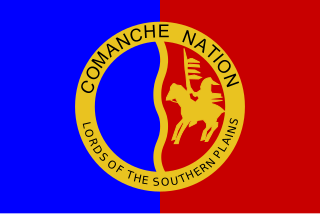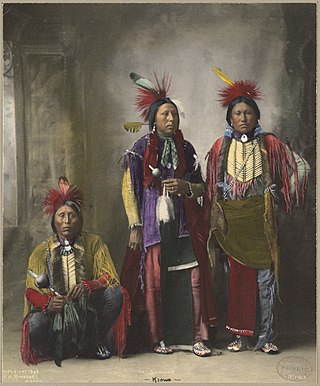Related Research Articles

The Comanche or Nʉmʉnʉʉ is a Native American tribe from the Southern Plains of the present-day United States. Comanche people today belong to the federally recognized Comanche Nation, headquartered in Lawton, Oklahoma.
Pawnee mythology is the body of oral history, cosmology, and myths of the Pawnee people concerning their gods and heroes. The Pawnee are a federally recognized tribe of Native Americans, originally located on the Great Plains along tributaries of the Missouri and Platte Rivers in Nebraska and Kansas and currently located in Oklahoma. They traditionally speak Pawnee, a Caddoan language. The Pawnees lived in villages of earth lodges. They grew corn and went on long bison hunts on the open plains twice a year. The tribe has four bands: the Skidi and "the South Bands" consisted of the Chawi, the Kitkahahki and the Pitahawirata Pawnee.

Kiowa or CáuigúIPA:[kɔ́j-gʷú]) people are a Native American tribe and an Indigenous people of the Great Plains of the United States. They migrated southward from western Montana into the Rocky Mountains in Colorado in the 17th and 18th centuries, and eventually into the Southern Plains by the early 19th century. In 1867, the Kiowa were moved to a reservation in southwestern Oklahoma.

The Fort Parker massacre, also known as the Fort Parker raid, was an event in which a group of Texian colonists were killed in an attack by a contingent of Comanche, Kiowa, Caddo, and Wichita raiders at Fort Parker on May 19, 1836. During the attack, Cynthia Ann Parker, then approximately nine years old, was captured and spent most of the rest of her life within the Comanche Nation, later marrying Chief Peta Nocona and giving birth to a son, Quanah Parker, who became a prominent leader of the Comanches and a war leader during the Red River War of 1874–75. Cynthia’s brother John Richard Parker was also captured and remained with the Comanches for six years before his release was negotiated. He was unable to readapt to Western society and chose to return to the Comanche Nation.

Quanah Parker was a war leader of the Kwahadi ("Antelope") band of the Comanche Nation. He was likely born into the Nokoni ("Wanderers") band of Tabby-nocca and grew up among the Kwahadis, the son of Kwahadi Comanche chief Peta Nocona and Cynthia Ann Parker, an Anglo-American who had been abducted as an eight-year-old child and assimilated into the Nokoni tribe. Following the apprehension of several Kiowa chiefs in 1871, Quanah Parker emerged as a dominant figure in the Red River War, clashing repeatedly with Colonel Ranald S. Mackenzie. With European-Americans hunting American bison, the Comanches' primary sustenance, into near extinction, Quanah Parker eventually surrendered and peaceably led the Kwahadi to the reservation at Fort Sill, Oklahoma.

Cynthia Ann Parker, Naduah, Narua, or Preloch, was a woman who was captured by a Comanche band during the Fort Parker massacre in 1836, where several of her relatives were killed. She was taken with several of her family members, including her younger brother John Richard Parker. Parker was later adopted into the tribe and had three children with a chief. Twenty-four years later she was relocated and taken captive by Texas Rangers, at approximately age 33, and unwillingly forced to separate from her sons and conform to European-American society. Her Comanche name means "was found" or "someone found" in English.

Mary Rowlandson, née White, later Mary Talcott, was a colonial American woman who was captured by Native Americans in 1676 during King Philip's War and held for 11 weeks before being ransomed. In 1682, six years after her ordeal, The Sovereignty and Goodness of God: Being a Narrative of the Captivity and Restoration of Mrs. Mary Rowlandson was published. This text is considered a formative American work in the literary genre of captivity narratives. It went through four printings in 1682 and garnered readership both in the New England colonies and in England, leading some to consider it the first American "bestseller".

Plains Indians or Indigenous peoples of the Great Plains and Canadian Prairies are the Native American tribes and First Nation band governments who have historically lived on the Interior Plains of North America. While hunting-farming cultures have lived on the Great Plains for centuries prior to European contact, the region is known for the horse cultures that flourished from the 17th century through the late 19th century. Their historic nomadism and armed resistance to domination by the government and military forces of Canada and the United States have made the Plains Indian culture groups an archetype in literature and art for Native Americans everywhere.

Captivity narratives are usually stories of people captured by enemies whom they consider uncivilized, or whose beliefs and customs they oppose. The best-known captivity narratives in North America are those concerning Europeans and Americans taken as captives and held by the indigenous peoples of North America. These narratives have had an enduring place in literature, history, ethnography, and the study of Native peoples.
Rachel Parker Plummer was the daughter of James W. Parker and the cousin of Quanah Parker, last free-roaming chief of the Comanches. An Anglo-Texan woman, she was kidnapped at the age of seventeen, along with her son, James Pratt Plummer, age two, and her cousins, by a Comanche raiding party.
Herman Lehmann was captured as a child by Native Americans. He lived first among the Apache and then the Comanche but returned to his Euro-American birth family later in life. He published his autobiography, Nine Years Among the Indians, in 1927.

Robert Brown was a British scientist, explorer, and author.

The Council House Fight, often referred to as the Council House Massacre, was a fight between soldiers and officials of the Republic of Texas and a delegation of Comanche chiefs during a peace conference in San Antonio on March 19, 1840. About 35 Comanche men and women under chief, Mukwooru represented just fraction of the Penateka band of the southern portion of the Comanche tribe. He knew he had no authority to speak for the Southern tribes as a whole and thus, any discussions of peace would be simply a farce. However, if Mukwooru could re-establish a lucrative trade with the San Antonian's perhaps a peace, by proxy, could be established. Just as the Comanche had done had been done for centuries in San Antonio, Santa Fe and along the Rio Grande. They would rob one settlement and sell to the other.
The Texas–Indian wars were a series of conflicts between settlers in Texas and the Southern Plains Indians during the 19th-century. Conflict between the Plains Indians and the Spanish began before other European and Anglo-American settlers were encouraged—first by Spain and then by the newly Independent Mexican government—to colonize Texas in order to provide a protective-settlement buffer in Texas between the Plains Indians and the rest of Mexico. As a consequence, conflict between Anglo-American settlers and Plains Indians occurred during the Texas colonial period as part of Mexico. The conflicts continued after Texas secured its independence from Mexico in 1836 and did not end until 30 years after Texas became a state of the United States, when in 1875 the last free band of Plains Indians, the Comanches led by Quahadi warrior Quanah Parker, surrendered and moved to the Fort Sill reservation in Oklahoma.

Tosahwi, meaning White Knife, was a Penateka Comanche chief. He was deemed "cooperative" by William Babcock Hazen.
Susannah Willard Johnson was an Anglo-American woman who was captured with her family during an Abenaki Indian raid on Charlestown, New Hampshire, in August 1754, just after the outbreak of the French and Indian War. Johnson and her family were marched for weeks through the wilderness of New England and Quebec before arriving at the Abenaki village in Saint-François-du-Lac, Quebec. The Johnsons were held for ransom until being sold off into slavery to the French.

The Comanche–Mexico Wars was the Mexican theater of the Comanche Wars, a series of conflicts from 1821 to 1870. The Comanche and their Kiowa and Kiowa Apache allies carried out large-scale raids hundreds of miles deep into Mexico. The raids were stimulated by the desire of Comanches to accumulate wealth through plunder, principally horses, mules, and Mexican captives for ransom or slaves who became integrated into the tribe. The raids escalated proportionally to Mexico's inability to defend its citizens during the turbulent years after it gained independence in 1821 and a large and growing market in the United States for stolen Mexican horses and cattle.
Leslie Spier was an American anthropologist best known for his ethnographic studies of American Indians. He spent a great deal of his professional life as a teacher; he retired in 1955 and died in 1961.
Big Red Meat was a Nokoni Comanche chief and a leader of Native American resistance against White invasion during the second half of the 19th century.
Hannah Swarton, née Joana Hibbert/Hibbard, was a New England colonial pioneer who was captured by Abenaki Indians and held prisoner for 5+1⁄2 years, first in an Abenaki community and later in the home of a French family in Quebec. She was eventually freed and told her story to Cotton Mather, who used it as a moral lesson in several of his works.
References
- ↑ Richard VanDerBeets, The Indian Captivity Narrative: An American Genre (Lanham, Maryland: University Press of America, 1984)
- 1 2 Walter Prescott Webb, "Introduction," in Nelson Lee, Three Years among the Comanches (new ed., Norman: University of Oklahoma Press, 1957)
- 1 2 Melburn D. Thurman, "Nelson Lee and the Green Corn Dance: Data Selection Problems with Wallace and Hoebel's Study of the Comanches," Plains Anthropologist 27 (1982).
- ↑ Handbook of Texas. Lee, Nelson (1807–1870). Richard Allen Burns, 1976. Updated: June 14, 2021
This article needs additional or more specific categories .(October 2023) |